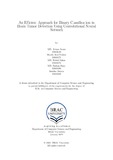| dc.contributor.advisor | Shakil, Arif | |
| dc.contributor.advisor | Parvez, Mohammad Zavid | |
| dc.contributor.author | Islam, MD. Arman | |
| dc.contributor.author | Noshin, Sheikh Araf | |
| dc.contributor.author | Islam, MD. Robiul | |
| dc.contributor.author | Razy, MD. Farhan | |
| dc.contributor.author | Antara, Samiha | |
| dc.date.accessioned | 2023-10-25T04:42:53Z | |
| dc.date.available | 2023-10-25T04:42:53Z | |
| dc.date.copyright | 2022 | |
| dc.date.issued | 2022-01 | |
| dc.identifier.other | ID 19101639 | |
| dc.identifier.other | ID 18101471 | |
| dc.identifier.other | ID 18101272 | |
| dc.identifier.other | ID 18101480 | |
| dc.identifier.other | ID 18101129 | |
| dc.identifier.uri | http://hdl.handle.net/10361/21881 | |
| dc.description | This thesis is submitted in partial fulfillment of the requirements for the degree of Bachelor of Science in Computer Science, 2022. | en_US |
| dc.description | Cataloged from PDF version of thesis. | |
| dc.description | Includes bibliographical references (pages 66-70). | |
| dc.description.abstract | Brain tumor detection using Convolutional Neural Network (CNN) models with
binary classification has significantly improved the reliability of medical imaging
through Deep Learning. The purpose of this research is to develop a modified CNN
model by altering the different layers and weight values of each node to attain similar
performance statistics to widely accepted CNN models while maintaining runtime
efficiency. The proposed CNN model incorporates binary cross entropy to analyze
the training data and accurately identifies whether or not a certain structured magnetic
resonance imaging (sMRI) picture contains a tumor. In comparison to existing
pre-trained CNN models, this study aims to contribute to the computer-aided diagnostic
(CAD) system by implementing the proposed model with a simplified time
complexity. The model achieved an overall classification accuracy of 96.7% after
extensive tweaking of the proprietary CNN architecture. The suggested system’s
performance is also compared with other existing systems, and the study demonstrates
that it performs on par with most of them. | en_US |
| dc.description.statementofresponsibility | MD. Arman Islam | |
| dc.description.statementofresponsibility | Sheikh Araf Noshin | |
| dc.description.statementofresponsibility | MD. Robiul Islam | |
| dc.description.statementofresponsibility | MD. Farhan Razy | |
| dc.description.statementofresponsibility | Samiha Antara | |
| dc.format.extent | 70 pages | |
| dc.language.iso | en | en_US |
| dc.publisher | Brac University | en_US |
| dc.rights | Brac University theses are protected by copyright. They may be viewed from this source for any purpose, but reproduction or distribution in any format is prohibited without written permission. | |
| dc.subject | CNN | en_US |
| dc.subject | Brain tumor | en_US |
| dc.subject | Data-sets | en_US |
| dc.subject | Deep learning | en_US |
| dc.subject | sMRI | en_US |
| dc.subject | CAD | en_US |
| dc.subject | Binary crossentropy | en_US |
| dc.subject.lcsh | Neural networks (Computer science) | |
| dc.title | An efficient approach for binary classification in brain tumor detection using convolutional neural network | en_US |
| dc.type | Thesis | en_US |
| dc.contributor.department | Department of Computer Science and Engineering, Brac University | |
| dc.description.degree | B.Sc. in Computer Science and Engineering | |

